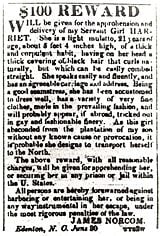Jacobs, Harriet
Serena Doose (talk | contribs) (Ready tag) |
({{Contracted}}) |
||
| Line 1: | Line 1: | ||
| − | {{Ready}} | + | {{Ready}}{{Contracted}} |
| − | {{epname}} | + | {{epname|Jacobs, Harriet}} |
[[Image:Harrietjacobs.gif|thumb|right|160px|''Harriet Jacobs]] | [[Image:Harrietjacobs.gif|thumb|right|160px|''Harriet Jacobs]] | ||
Revision as of 15:30, 7 November 2007
Harriet Ann Jacobs (1813 - March 7, 1897) was an American abolitionist and writer. In 1861, she published Incidents in the Life of a Slave Girl under the pseudonym Linda Brent.
She was born in Edenton, North Carolina to Daniel Jacobs and Delilah. Her father was a mulatto slave owned by Dr. Andrew Knox. Her mother was a mulatto slave owned by John Horniblow, a tavern owner. Harriet inherited the status of both her parents as a slave by birth. She was raised by Delilah until the latter died around 1819. She then was raised by her mother's mistress, Margaret Horniblow. Margaret taught Harriet to read, write, and sew.
In 1825, Margaret Horniblow died, and Harriet was willed to Horniblow's niece, whose father, Dr. James Norcom, became her new master. Norcom subjected her to sexual harassment for nearly a decade. He refused to allow her to marry any other man, regardless of status. Harriet had a consensual lover, Samuel Sawyer, who was a free white man and a lawyer who eventually became a Senator. She and Sawyer were parents to two children (named Benny and Ellen in the book),also owned by Norcom. Harriet reported that Norcom threatened to sell her children if she refused his sexual advances.
By 1835, her domestic situation had become unbearable, and Harriet managed to escape. She lived for seven years in a small crawlspace in her grandmother's attic before escaping by boat to Philadelphia, Pennsylvania. She started living as a free woman and later moved to New York City in 1842. She found employment as a nursemaid. Her most notable employer was the abolitionist Nathaniel Parker Willis. Harriet was one of many escaped slaves who wrote autobiographical narratives in an effort to shape opinion in the Northern United States on the "peculiar institution" of slavery.
Her autobiographical accounts started being published in serial form in the New York Tribune, owned and edited by Horace Greeley. However her reports of sexual abuse were considered too shocking to the average newspaper reader of the day, and publication ceased before the completion of the narrative. Harriet later found difficulty in selling her completed manuscript.
She eventually managed to sign an agreement with the Thayer and Eldridge publishing house. The publishers hired Lydia Child to edit the story and brought her in contact with Harriet. The two women would remain in contact for much of their remaining lives. However Thayer and Eldridge declared bankruptcy before the narrative could be published. The narrative in its final form was published by a Boston, Massachusetts publisher in 1861.
The author appealed mainly to Middle class white Christian women in the North, through her descriptions of slavery destroying the virtue of women through harassment and rape.
She criticized the religion of the Southern United States as being un-Christian and as emphasizing the value of money ("If I am going to hell, bury my money with me," says a particularly brutal and uneducated slaveholder). She described another slaveholder in the sentence, "He boasted the name and standing of a Christian, though Satan never had a truer follower." Jacobs argued that these men were not exceptions to the general rule.
Much of Incidents in the Life of a Slave Girl is devoted to the Jacobs' struggle to free her two children after she runs away herself. In one heart-rending scene, Linda spends seven years hiding in a tiny space built into her grandmother's barn in order to occasionally see and hear the voices of her children. Jacobs changed the names of all characters in the novel, including her own, to conceal their true identities. Despite documents of authenticity, many have accused the narrative to be based on false accounts. The villainous slave owner "Dr. Flint" was clearly based on her former master, Dr. James Norcom.
Jacobs found employment as a nurse during the American Civil War. Her correspondence with Child reveals her enthusiasm over the Emancipation Proclamation of 1862. She felt that her suffering people were finally free. The Thirteenth Amendment to the United States Constitution of 1865 would indeed put an end to slavery. Jacobs lived the latter years of her life in Washington, D.C..
Notes
ReferencesISBN links support NWE through referral fees
Shockley, Ann Allen, Afro-American Women Writers 1746-1933: An Anthology and Critical Guide, New Haven, Connecticut: Meridian Books, 1989. ISBN 0-452-00981-2
External links
- Harriet Ann Jacobs: Writer and Activist. Retrieved October 14, 2007.
- Harriet Ann Jacobs (1813-1897). Retrieved October 14, 2007.
- Works by Harriet Jacobs. Project Gutenberg. Retrieved October 14, 2007.
- Essays by Harriet Jacobs at Quotidiana.org. Retrieved October 14, 2007.
Warning: Default sort key "Jacobs, Harriet Ann" overrides earlier default sort key "Jacobs, Harriet".
Credits
New World Encyclopedia writers and editors rewrote and completed the Wikipedia article in accordance with New World Encyclopedia standards. This article abides by terms of the Creative Commons CC-by-sa 3.0 License (CC-by-sa), which may be used and disseminated with proper attribution. Credit is due under the terms of this license that can reference both the New World Encyclopedia contributors and the selfless volunteer contributors of the Wikimedia Foundation. To cite this article click here for a list of acceptable citing formats.The history of earlier contributions by wikipedians is accessible to researchers here:
The history of this article since it was imported to New World Encyclopedia:
Note: Some restrictions may apply to use of individual images which are separately licensed.
